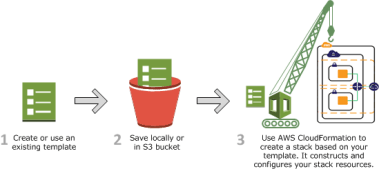You have started an AWS account and are ready to use a selection of AWS services and resources to bring your business to the cloud. The trouble is, how do you organize and provision them in a simple, orderly way?
Enter the AWS CloudFormation service. With just a simple file template, developers and businesses may manage and provision stacks of resources within your AWS cloud.
With the template, CloudFormation lets you automatically model and provision the resources required by your applications throughout all your AWS accounts, in any region.
To use CloudFormation, you create your infrastructure using code via (YAML or JSFON formats), or use a sample template. You can check out your code or send it to an S3 bucket. You may then use CloudFormation to generate stacks from your template. From there, AWS CloudFormation automatically provisions and manages stacks and resources according to your specifications.
Features
- Templates – Using AWS CloudFormation, you can create a model for your infrastructure to follow. With this, you may replicate and standardize your infrastructure components for your whole enterprise. This means that it is easier to detect and fix problems and make sure everything complies with set standards.
- Automated Provisioning – With CloudFormation, you may provision resources automatically, as many times as needed. You may then create your infrastructure and applications without manual intervention. CloudFormation handles choosing the right actions to take when handling your stacks, and will undo changes in the event of failures.
- Make your infrastructure as code – You can create your infrastructure using any code editor, monitor it using version control, and have it go through quality assurance prior to deployment.
Best of all, this is free of charge, and you only pay for the AWS services you are currently using. Contact us via https://www.copebit.ch/about-us/ if you need any help with AWS or CloudFormation.
